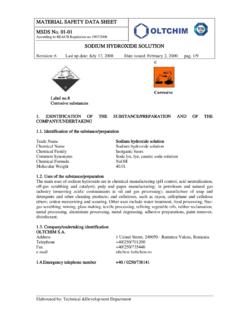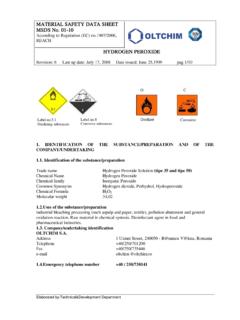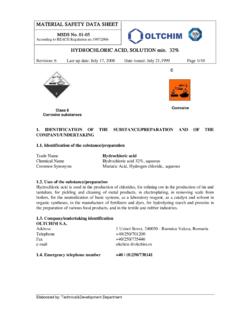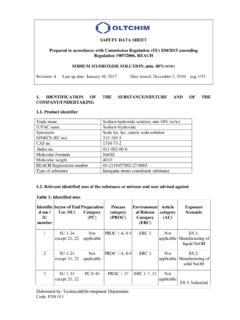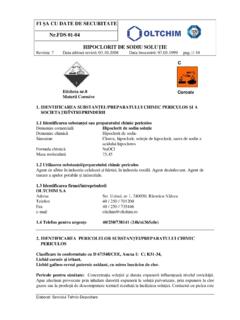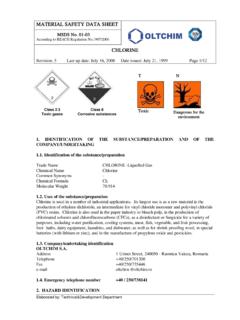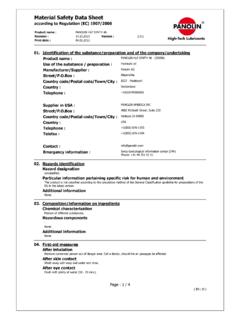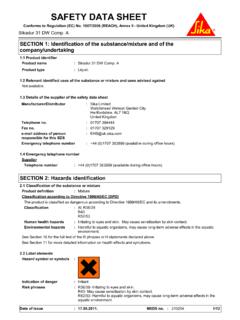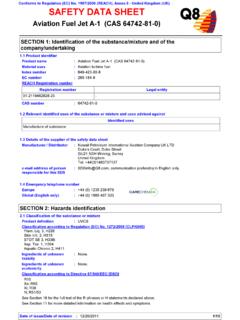Transcription of SAFETY DATA SHEET - Oltchim
1 SAFETY data SHEET Prepared in accordance with Annex II of the REACH regulation ec 1907 / 2006 , Regulation (EC) 1272/2008 and Regulation (EC) 453/2010 POLYVINYL CHLORIDE Revision: 0 Last up date: Date issued: January 05, 2010 Page 1/10 Elaborated by: Technical&Development Department 1. IDENTIFICATION OF THE SUBSTANCE/PREPARATION AND OF THE COMPANY/UNDERTAKING Substance Identification Trade name OLTVIL Chemical name Polyvinyl chloride (various K-values) Synonym Chloroethylene polymer, PVC CAS # 9002-86-2 Molecular Formula (-CHCl - CH2 -)n Chemical characterization Polymer REACH Registration number Excepted from registration according to Regulation (EC) 1907/ 2006 Relevant identified uses of the substance or mixture and uses advised against Insulating panels, doors and windows Pipes and fittings Electric cables insulation, weather resistant cables shielding, injected shoe soles, drums and containers Medical applications Toys, consumer goods and everyday life Uses advise against: There are no uses advised against.
2 Details of the supplier of the SAFETY data SHEET Name Oltchim Address 1 Uzinei Street, 240050 Ramnicu Valcea, Romania Phone N +40 250 701 200 FAX N +40 250 735 030 E-mail of competent person responsible for SDS in the MS or in the EU: SAFETY data SHEET Prepared in accordance with Annex II of the REACH regulation ec 1907 / 2006 , Regulation (EC) 1272/2008 and Regulation 453/2010 POLYVINYL CHLORIDE Revision:0 Last up date: Date issued: January 05, 2011 Page 2/10 This information only concerns the above mentioned product and does not need to be valid if used with other product(s) or in any process. The information is to our best present knowledge correct and complete and is given in good faith but without warranty. It remains the user's own responsibility to make sure that the information is appropriate and complete for his special use of this product Emergency telephone European Emergency N : 112 Emergency telephone at the company: +40/250/738141 Available outside office hours: 24h/day/365days 2.
3 HAZARD IDENTIFICATION Classification of the substance Classification according to Regulation (EC) 1272/2008 Polyvinyl chloride (PVC) is not classified according to Regulation (EC) 1272/2008 Classification according to Directive 67/548/EEC Polyvinyl chloride (PVC) is not classified according to Directive 67/548/EEC Label elements Labeling according to Regulation (EC) 1272/2008 Signal word: No signal word No label according to Regulation (EC) 1272/2008. Labeling according to Directive 67/548/EEC No label according to D 67/548/EEC. Other hazard Health effects: Not normally considered a health hazard. The content of residual vinyl chloride monomer is max. 0,0001 %, so the polyvinyl chloride presents no health effects. Environmental effects: No critical hazard to the environment in the ordinary sense of valid regulations . Polyvinyl chloride is not classified as dangerous for environmental. SAFETY data SHEET Prepared in accordance with Annex II of the REACH regulation ec 1907 / 2006 , Regulation (EC) 1272/2008 and Regulation 453/2010 POLYVINYL CHLORIDE Revision:0 Last up date: Date issued: January 05, 2011 Page 3/10 This information only concerns the above mentioned product and does not need to be valid if used with other product(s) or in any process.
4 The information is to our best present knowledge correct and complete and is given in good faith but without warranty. It remains the user's own responsibility to make sure that the information is appropriate and complete for his special use of this product Emergency overview: Polyvinyl chloride is a white odourless powder. When heating above decomposition temperature it will form toxic gases: carbon monoxide, carbon dioxide and gaseous hydrochloric acid. PVC handling procedures should be chosen so that it minimizes the formation of dust in the work area. 3. COMPOSITION/ INFORMATION ON INGREDIENTS Chemical name PBT/ vPvB CAS no Classification according to Reg (EC) ) Classification according to D67/548/EC Concentration, % (w/w) Polyvinyl chloride No/No 9002-86-2 no no 100 Impurities No impurities relevant for classification and labeling. The content of residual vinyl chloride monomer is max. 0, 0001 %, so this impuritie is not relevant for classification and labeling. 4.
5 FIRST AID MEASURE Description of first aid measures General Advice: If exposed or if you feel unwell: Call a Poison Center or doctor/physician. Show this SAFETY data SHEET to the doctor in attendance. If Inhaled: Remove to fresh air. Get medical attention if necessary. In case of skin contact: Flush with plenty of water and soap immediately. In case of eye contact: Wash eyes immediately with large amounts of water, occasionally lifting upper and lower eyelids, until no evidence of chemical remains at least 15-20 minutes. Do not rub the eyes. See physician if residual foreign body is suspected or irritation persists. If ingested: No effects expected because the material is practically inert. Call a physicien if necessary. Most important symptoms and effects, both acute and delayed By inhalation: Dust inhalation may cause irritation of nose, throat and lungs. By eye contact: PVC dust causes irritations and abrasions on eye.
6 SAFETY data SHEET Prepared in accordance with Annex II of the REACH regulation ec 1907 / 2006 , Regulation (EC) 1272/2008 and Regulation 453/2010 POLYVINYL CHLORIDE Revision:0 Last up date: Date issued: January 05, 2011 Page 4/10 This information only concerns the above mentioned product and does not need to be valid if used with other product(s) or in any process. The information is to our best present knowledge correct and complete and is given in good faith but without warranty. It remains the user's own responsibility to make sure that the information is appropriate and complete for his special use of this product By skin contact: PVC dust causes irritations and abrasions on skin. By ingestion: No effects expected because the material is practically inert Indication of immediate medical attention and special treatment needed No specific antidote. Treat symptomatically and supportively. 5. FIRE - FIGHTING MEASURES Extinguishing media Suitable extinguishing media: Dry powder, carbon dioxide, water.
7 Unsuitable extinguishing media: None Special hazards arising from the substance or mixture Exposure hazards: This product is nonflammable and nonexplosive under normal conditions of use. When forced to burn, the major gaseous products of combustion of PVC resin are carbon monoxide, carbon dioxide and gaseous hydrochloric acid. Hazardous combustion products: When heating above decomposition temeperature it will form toxic gases: carbon monoxide, carbon dioxide and gaseous hydrochloric acid. Advice for firefighters Special precautions for fire-fighters: Fire water contaminated with this material must be contained and prevented from being discharged to any waterway, sewer or drain. Protection of fire-fighters: Wear full protective equipment and self-contained breathing apparatus. Remarks: Use water spray to keep fire-exposed containers cool. 6. ACCIDENTAL RELEASE MEASURES . Personal precautions, protective equipment and emergency procedures For non-emergency personnel: Keep unnecessary and unprotected personnel away from entering.
8 Avoid contact with skin, eyes, and clothing wear suitable protective equipment (see section 8). Do not touch or walk through spilt material. Shut off all ignition sources. SAFETY data SHEET Prepared in accordance with Annex II of the REACH regulation ec 1907 / 2006 , Regulation (EC) 1272/2008 and Regulation 453/2010 POLYVINYL CHLORIDE Revision:0 Last up date: Date issued: January 05, 2011 Page 5/10 This information only concerns the above mentioned product and does not need to be valid if used with other product(s) or in any process. The information is to our best present knowledge correct and complete and is given in good faith but without warranty. It remains the user's own responsibility to make sure that the information is appropriate and complete for his special use of this product For emergency responders: Persons performing clean-up work should wear adequate personal protective equipment and a respirator filter for organic vapour and harmful dust. Remove all sources of ignition from the affected area.
9 Environmental precautions Environmental precautions: Prevent from contamination the ground and surface water by isolating the work area. The risks for environmental spreading of this material are low because of the absence of water solubility or soil mobility of PVC, the material is practically inert . Methods and materials for containment and cleaning up Methods of cleaning up: Contain spillages with dike to prevent dusting, spreading on soil or entry into the surface water, then transfer into other closed containers. Use appropriate way to prevent dusting-vacuum cleaner, shovel. Recover containers if possible and dispose according to applicable local environmental regulations . In case of necessary flushing contaminated area with water, the resulted waste waters will be treated according to applicable local environmental regulations . Special precautions: None Reference to other sections Additional advice: Refer to section 8, 13. 7.
10 HANDLING AND STORAGE Precautions for safe handling Handling: PVC is not a hazardous material in most of industrial operations. PVC handling procedures should be chosen so that it minimizes the formation of dust in the work area (pneumatic transport, dust filter). Not eat, drink or smoke during handling. Advice on general occupational hygiene: Avoid dust generation. General occupational hygiene measures are required to ensure safe handling of the substance. These measures involve good personal and housekeeping practices ( regular cleaning with suitable cleaning devices), no drinking, eating and smoking at the workplace. Shower and change clothes at end of work shift. Do not wear contaminated clothing at home. SAFETY data SHEET Prepared in accordance with Annex II of the REACH regulation ec 1907 / 2006 , Regulation (EC) 1272/2008 and Regulation 453/2010 POLYVINYL CHLORIDE Revision:0 Last up date: Date issued: January 05, 2011 Page 6/10 This information only concerns the above mentioned product and does not need to be valid if used with other product(s) or in any process.
